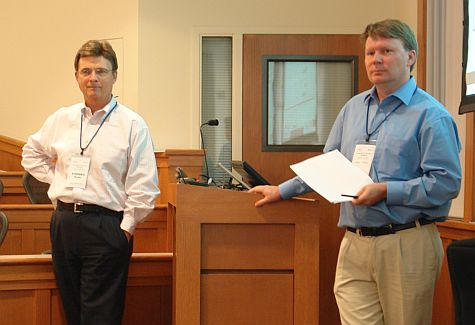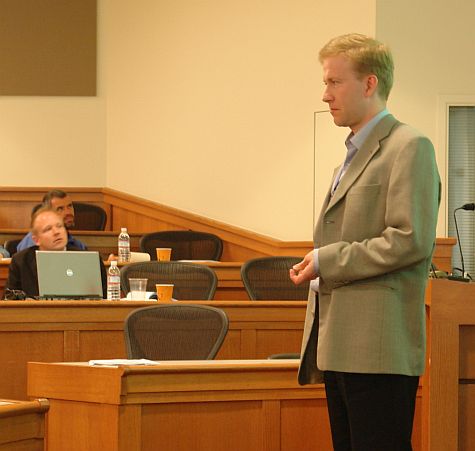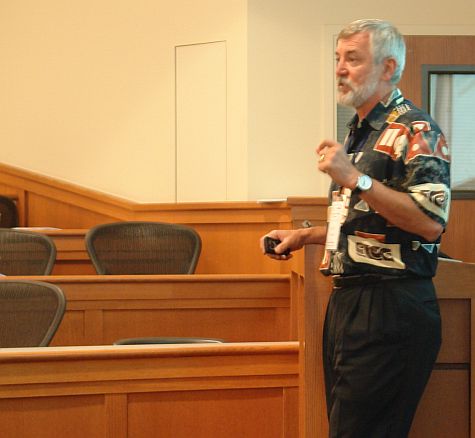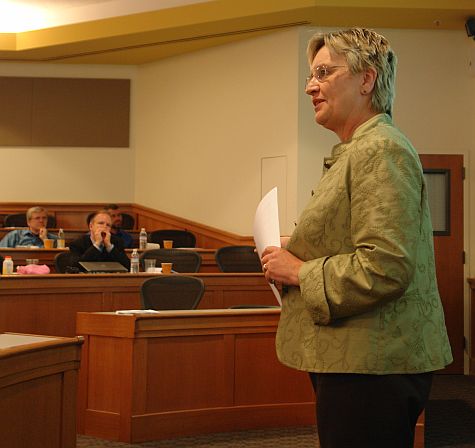This digest was created in real-time during the meeting, based on the speaker's presentation(s) and comments from the audience. The content should not be viewed as an official transcript of the meeting, but only as an interpretation by a single individual. Lapses, grammatical errors, and typing mistakes may not have been corrected. Questions about content should be directed to the originator. The digest has been made available for purposes of scholarship, posted on the Coevolving Innovations web site by David Ing.
Discussant: Mary Jo Bitner, Arizona State University
Papers:
- “Service-Logic Innovations: How to Innovate Customers, Not Products”, Michel, Brown, and Gallan
- “Managing Service Ideas and Suggestions – Information Systems in Innovation Brokering”, Ahonen and Lietsala
- “Service Innovation Using Design Patterns”, by Robert Glushko and Christo Sims
- “Service Blueprinting: A Practical Tool for Service Innovation”, by Bitner, Ostrom, and Morgan
“Service-Logic Innovations: How to Innovate Customers, Not Products”, Stefan Michel, Stephen W. Brown, and Andrew S. Gallan

Steve Brown, Arizona State University
Premises that may be provocative
- We feel that all innovations, whether to service processes or products are service logic innovation
- Argue that service logic innovation innovate customers
- To have an innovation, a customer must be involved in co-creating the service
Thinking about significant innovations in our time, they would be difficult to explain to traditional innovation literature
- Netflix
- Ikea
- European free fast-read newspapers in major cities
Contrast a goods-logic approach from a service-logic approach
- Will illustrate with 26 case studies
Goods-logic innovation, goods-dominant perspective
- Lusch & Vargo introduced Service Logic, leads to this
- 9 postulates ... including:
- Goods are distribution mechanism for service provision: goods are a means to an end
- The customer is always a co-creator of value, e.g. Google needs user
- All that a firm can do is make value propositions, it's up to the customer to see whether they generate value
Goods logic versus service logic (table)
[Stefan]
Looking for things we don't understand, collected cases, looking for a pattern
Found service-dominant logic was helpful to understand these
Categories:
- Buyer
- Customer's role
- Co-creator of value
- Uses Sheth and Mittal 2004: sometimes can be in multiple roles simultaneously
Innovating:
- Smart offerings: embed know-how and skills into products
- This doesn't make sense in the traditional goods-dominant logic
- Value integration: what does the customer do versus firm
- Value constellation: reconfiguring, number of players increased
3x3 matrix, always at least a change in the customer role, and the firm's value creation role -- although there's sometimes more, so they're not exclusive
| Change of Customer Role | ||||
| Change of firm's value creation | ||||
Glucose monitoring system: intelligence of doctors embedded into product, so customer can do itself
U. of Phoenix: targets market that traditional universities can't, less integrated resources
Multiplex cinemas: doesn't change the user role (same movie), but the way the users buy movies (go to a theatre, and see what's playing)
Pitney Bowes: offers a different value integration that changes all three roles, having started from selling meters for stamps, evolving to taking over whole logistics of mail, insourcing all mail, changing the user role, the buyer role and payer
Ikea: Ikea catalog has high circulation worldwide, next to the bible!
Managerial standpoint:
- How to change the customer role outside in; versus firm role inside out
- A lot of marketing literature focuses on buying, not using: dangerous
- Find out what customers stay away (Drucker)
- Eliminate waste in the buying process
- Change the payer (e.g. executive education is great, but students can't pay, so maybe should get a bank to pay for a financial services course)
- ...
Inside-out service logic innovation
- What are the value constellations
- Increase the density of your offering
- Integrate more to relieve your customer
- Integrate less to enable your customer
[Questions]
End is not the provision of the service, but consumption of the service. Business value, how to capture?
- Try to avoid consumption, because it means destroy
- Difference is between value in use, and value in exchange
- Traditional marketing is focused on value in exchange, which is economic
- Shift from buyer to how it creates value
- Value that the customer can co-create leads to willingness to pay
- Should be more open on willingness to pay
- e.g. newspapers provide podcasts, but can't charge for that
- Looking at the three roles of the customer, make it more accessible for managers
Resource-based view, looking at value, means customers are willing, would get a price level. Value constellation is more difficult to copy.
- Was reviewing a paper on SD logic, and asked how it links to RBV, still waiting for this.
Vargo & Lusch are relabelling a few things
- Particularly in the book
“Managing Service Ideas and Suggestions – Information Systems in Innovation Brokering”, Miko Ahonen and Katri Lietsala

Miko Ahonen, U. of Tampere, Hypermedia Laboratory (that does games research, open source research)
Focus on information systems and brokering
- Intermediaries are like brokers
- Have evaluated 3 services with a certain brokering model, from Hargadon and Sutton
Kelley & Storey 2000, were focused on service firms in the UK
- After 150 companies, found no systematic innovation process for the companies
- Could those information systems or marketplaces be used in developing services?
Open Innovation (Chesbrough 2006), question of intermediaries
- Many variations coming with this
- No single path, companies have to work with partners, consumers, sometimes sell and negotiate IP
- Is a middleman needed, or a person, or can an information system do the job?
It's much about trust
- Wolpert 2002: Intermediaries work between companies
- Can information systems be trusted?
Hargadon & Sutton 1997 knowledge broker (technology brokering)
- HBR article easier than the ASQ article
- How to extend this to social media?
- 1. Capture good ideas
- 2. Keep ideas alive
- 3. Imagine new uses for old ideas
- 4. Put promising concepts to the test
Innocentive as a case, can only support 1 or 2 of Hargadon & Sutton
Looked at del.icio.us, as it captures good ideas with an open API
Interest in collective creativity, Hargadon & Bechky 2006 (analysis of consulting companies)
- Should be some reflective reframing that goes on, but many systems are just request and proposal
- How can collaborators develop ideas?
Social media is about online technologies, sharing in certain formats
Success factors of Web 2.0 services
- 1. Early entry / first mover: getting a user base, really fast
- 3. Localization important
- 6 ...
Company or firm perspective, working as an intermediary
- Not much communication between innnovators and company
- Innocentive, from company to innovators
- Ideawicket starts from innovators
- Del.icio.us would be of this class
Future work:
- Will do some interviews, need to choose many innovation marketplaces
- Are developing a mobile tool, using the knowledge brokering model
- Will look at Steven Alter's work system framework
[Questions]
Study inside companies, e.g. Nokia
- Main financier is Ericsson
How do Innocentive and Ideawicket make money:
- Innocentive is a middleman, takes a certain amount of money
- Ideawicket claim that they will seek out financier, and will also take some money, but their challenge is to get a user base and enough interested companies
- Ideawicket is well-built as an information system
9sigma is under Innocentive
“Service Innovation Using Design Patterns”, by Robert Glushko and Christo Sims

Bob, Silicon-valley refugee
Working with a graduate student, Christo Sims, working not just person-to-person, but also web-based services, machine-to-machine
- Frameworks are not abstract enough
- More computer science background, to generate new service ideas
Will survey, talk about some patterns
- Plastered on the wall, thinking about them
- Want to get to a large selection of patterns to see what works
- Trying to invent patterns, and select the ones that are good
Thinking about design spaces: 8-space
What do services have in common, when we're talking about web services and person-to-person services
- Customer and supplier, then not much
- If abstract, could manipulate in head or on a machine
Pattern: generable, adaptable, and worthy of imitation so that it can be reused
- Patterns can be used description, as a situation for solution
- Could be used to encourage best practices
- As abstract, they can help invention
Some patterns, in a stack at levels of organizations, down to individual services
Example: Betancourt and Gautschi: 25 patterns of production, distribution and consumption activities
- e.g. education can be produced, delivered and consumed as a brainstorm session, lecture, posted on a web
- Can see which ones make sense
MIT business patterns, Tom Malone
- Four kinds of assets: financial, phyiscal, intangible, human
- Archetype: creator, distributor, landlord, broker
- Can zoom through a pattern explorer
- e.g. see where Amazon fits (as "distribute books via electronic store")
In consulting firms like IBM, looking at components
- Component Business Model, a description of how the business works
- Perspectives (executive roles ....) vs. activities
- Best practices
- Could outsource one of the components
Supply Chain Operations Reference model (SCOR)
Drop shipment pattern, most common on the Internet
- Retailer, banker, credit authority, delivery service
Front stage and backstage
- Things invisible to the customer and things they see
Apte and Mason (early paper): information intensity, customer need, ...
- Carve them out
Glusko and Sims: looking at design framework for services, 8 dimensions
- Who gets responsibilities for delivery?
- Covers not just person-to-person, but also machine to machine
- Knowledge /expertise
- Cognitive capability
- Physical capatiblity
- ...
- Technolgy and captial
- Disposible resources
- Encoded information
[Questions]
There's lots of other dimensions. How decide those that are more or less important
- Want a small number, e.g. 8, but 25 is too many
Value capture?
- Will generate an infinite of services, and let you figure out what is important
- A framing for designers not evaluators
Does Malone look at value capture?
- Yes, but at the granularity, firms do multiple things
Christopher Alexander patterns
- In document-centric domain, have done this down to document patterns
- Haven't gotten to do this in the more general sense of patterns, yet
Copenhagen Business School: similar framework comparing airlines as components
“Service Blueprinting: A Practical Tool for Service Innovation”, by Mary Jo Bitner, Amy L. Ostrom, and Felicia N. Morgan

Mary Jo Bitner
Something different from what I usually present
- Have done a lot on service encounters
- Today, will show a tool, has evolved over 20 years
- A practical tool for customer-focused service innovation
There's a need for innovation in services, but we don't have a lot of tools
- Have used this with different companies
There's little written about service blueprinting
Service blueprinting can help ...
- processes
- customer experiences
- Service development and design
Service is blueprinting
- A tool for simulaneously depicting
- processes
- points of contact
- evidence of service
- from a consumer's point of view
Start from customer activities, and then work backwars into contact employee, backstage and support processes
- One response: customers have no idea what we're doing for them, because there was no tangible evidence of the service
e.g. one night in a hotel room.
- (It looks like process swim lanes!)
Cases of companies that have used blueprinting
Yellow Transportation, has been working with ASU ten years ago
- YRC worldwide
- Ten years ago, ranked as worst company in industry
- For last five years, have been ranked as first
- They used service blueprinting in many ways
- Used blueprinting to design new services, e.g. Exact Express guaranteed services, that no one else had done this
- Also used it for core service improvements
- A-ha: 20,000 Teamsters needed to understand the value provided to customers
- Introduced a customer-centric change program

This work is licensed under a Creative Commons Attribution-NonCommercial-ShareAlike 4.0 International License